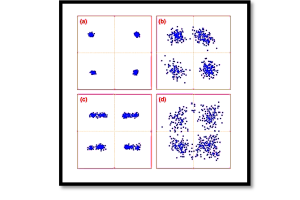
Harnessing the Power of M-ary Data Transmission and Nyquist’s Channel Capacity
As the demand for faster and more efficient communication systems grows, the need to maximize data rates within given bandwidth constraints becomes paramount. While binary data transmission has traditionally been the cornerstone of digital communication, the transition to M-ary signaling and the application of Nyquist’s formula have revolutionized channel capacity. This blog provides a comprehensive understanding of these concepts.
Binary Data Transmission: The Starting Point
Binary data transmission relies on two discrete states, typically represented as 0 and 1. Each bit is transmitted in a fixed time interval, Tb, making binary systems straightforward but somewhat limited in efficiency.
For example, in a binary system with a baud rate of 10, the bit rate is also 10 bps, as each signal unit represents a single bit. The image demonstrates this principle, where the waveform alternates between high and low states to encode binary data. However, as data demands increase, binary transmission alone may not suffice. This is where M-ary systems come into play.
M-ary Data Transmission: Expanding the Horizon
M-ary signaling extends binary transmission by using multiple discrete states. In an M-ary system, each signal unit can represent more than one bit, significantly increasing the data rate without requiring additional bandwidth. The relationship between the number of signal levels (M) and the bits per symbol is given by: M=2n
Where n is the number of bits per symbol. For instance:
- If M=4, n=2, meaning each symbol encodes 2 bits.
- A system with a baud rate of 4 and M=4 achieves a bit rate of 4×2=8 bps
This ability to represent multiple bits per signal unit allows M-ary systems to deliver higher throughput while conserving bandwidth.
Nyquist Formula: The Theoretical Limit
The Nyquist theorem provides a mathematical framework for determining the maximum achievable data rate of a communication channel. It states that the channel capacity (C) is proportional to the bandwidth (BBB) and the number of discrete signal levels (M):

The image shown visually represents how increasing M enhances the channel capacity. However, it’s important to note that higher M requires a greater signal-to-noise ratio (SNR) to maintain reliable communication.

Applications of Nyquist’s Formula
- Optimizing Bandwidth: Nyquist’s theorem helps engineers design systems that maximize data rates within given bandwidth constraints.
- Improving Network Efficiency: Techniques like multilevel signaling use Nyquist’s principles to deliver higher throughput in networks.
- Future-proofing Communication Systems: As technologies like 5G continue to evolve, the Nyquist formula remains a critical tool for pushing the boundaries of channel capacity.
Binary vs. M-ary: A Comparison
While binary systems are simple and robust, M-ary signaling offers significant advantages in terms of data rate efficiency. The transition from binary to M-ary is a natural evolution in communication technology, driven by the need for higher performance and more efficient bandwidth utilization. The image contrasts the two systems, highlighting how M-ary signaling achieves higher bit rates with the same baud rate by encoding multiple bits per symbol.

Take our entry level course (Below) for free using coupon code RAHRF101BLOG
RF Fundamentals, Basic Concepts and Components – RAHRF101
For limited time take an additional 10% off of all our courses using coupon code RFCERT10
Rahsoft RF Certificate and courses
Conclusion
The evolution from binary to M-ary transmission and the application of Nyquist’s theorem represent the forefront of digital communication innovation. These concepts enable higher data rates, improved bandwidth utilization, and the ability to meet the growing demands of modern communication systems. As we move forward, leveraging these principles will be essential for building faster, more efficient, and more reliable networks.

Learn more about this topic by taking the complete course ‘Introduction to Modulation in Communication Systems Online Course – RAHRF152’. Watch the course videos for more detailed understanding. Also checkout other courses on RF system and IC design on https://rahsoft.com/courses/. Rahsoft also provides a certificate on Radio Frequency. All the courses offer step by step approach.
Tag:M-ary, Nyquist, Transmission



